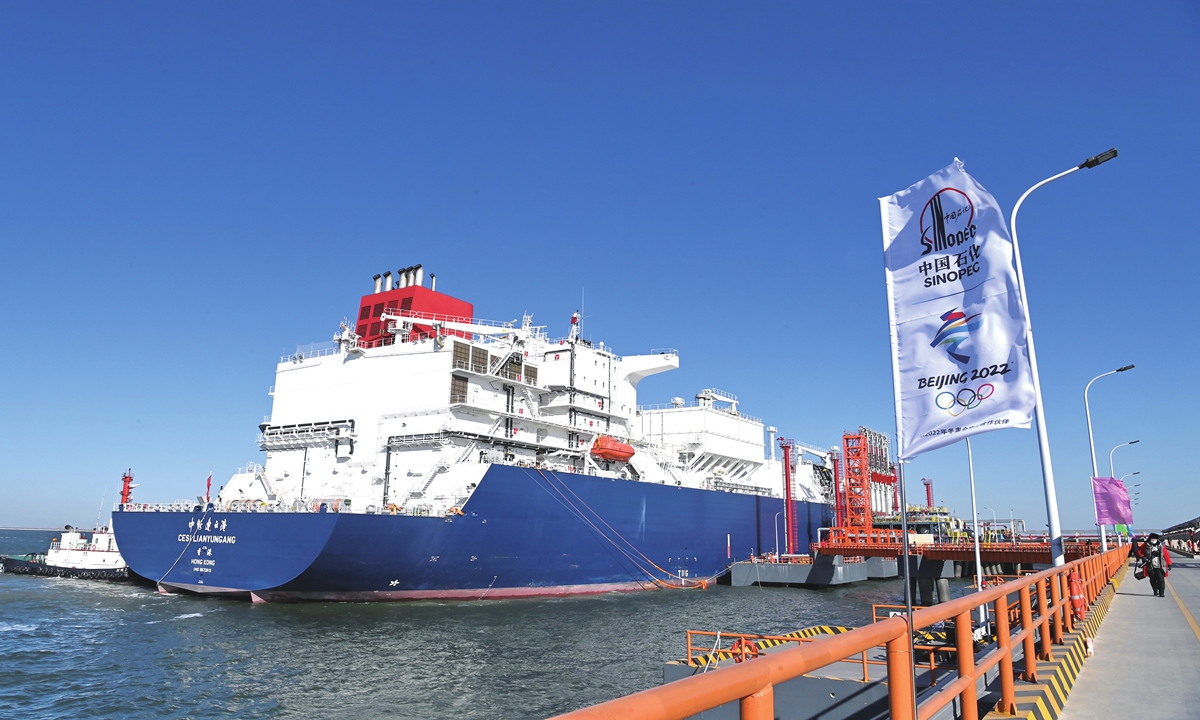China surpasses South Korea as world’s No. 1 shipbuilder in 2021
Over taking South Korea in 2021 to become champion of annual order volume

The CESI Lianyungang carrying 69,000 tons of LNG berths at Tianjin LNG terminal on December 29, 2021. Photo: CNSphoto
The annual order volume of South Korean shipping companies had ranked first in the world since 2018, but was overtaken by China in 2021. Although South Korea has extended significant effort to remain No.1, its shipping companies finally had to accept the fact that they were surpassed by their Chinese counterparts.
China's shipbuilding ability has kept on improving with domestically developed technologies and patents, analysts said. More orders will be placed through Chinese shipwrights in the future.
According to data released on Sunday by Clarkson, a British shipbuilding and shipping industry analyst, the global order volume of new ships in 2021 was 45.73 million compensated gross tons (CGTs), of which South Korea received 17.35 million CGTs, accounting for 38 percent, second only to China's 22.8 million CGTs.
By the end of November 2021, China's in hand ship orders reached 96.39 million deadweight tons (DWTs), up 35.9 percent year-on-year, according to statistics from the China Association of the National Shipbuilding Industry.
Analysts attributed the position shift to huge demand for container ships, the orders of which were mostly won by China last year.
South Korean media reported that South Korea has focused on high value-added orders such as liquefied natural gas (LNG) carriers.
In September, the average cost of each ship was $170 million for South Korean firms and $60 million for Chinese firms. While the volume of new orders is smaller than that of China, the "gold content" of orders received in South Korea is higher, media reported.
South Korea currently accounts for 91 percent of global orders for LNG carriers, compared with 9 percent for China.
China is good at shipbuilding, including building general cargo carriers. The tonnage of normal cargo ships is larger than that of South Korea, Lin Boqiang, director of the China Center for Energy Economics Research at Xiamen University, told the Global Times on Monday.
"The reason for China's low order numbers of LNG carriers is due to the low demand in the past. The quantity will come up as demand increases," said Lin.
Fast-growing industry
According to Lin, LNG carriers are professional ships and cannot be used for LNG transportation. South Korea's LNG carrier manufacturing technology is strong due to historical development and large demand.
But analysts and industry insiders said that China now has the ability to domestically build LNG carriers.
For instance, Hudong-Zhonghua Shipbuilding and China Shipbuilding Trading will build three large-scale 174,000-cubic-meter LNG carriers for COSCO Shipping Energy Transportation Co. The deal was signed on December 7, 2021, with a total value of $554 million.
The construction of LNG carriers is a complex process, and relies on advanced equipment. It is of high cost and imposes high technical requirements. Carriers need to transport liquefied gas in the ultra-low temperature environment of -163 C. Only a few countries in the world with construction capacity across its shipyards can do this work, an industry insider surnamed Xu told the Global Times.
Subsidiaries of China Shipbuilding Industry Company - Jiangnan Shipyard (Group) Co and China Shipbuilding Trading Co - officially delivered Pacific Ineos Belstaff, a 99,000-cubic-meter very large ethane carrier (VLEC), on December 28, 2021.
It is the first VLEC with the largest cabin capacity and B-type cabin in the world. The B-type tank can carry a variety of liquefied gas cargoes including liquefied petroleum gas, ethylene and ethane.
The difficulty of B-type tank construction is significantly greater than that of the LNG carriers, said Xu.
Jiangnan Shipyard's newly developed 93,000-cubic very large LPG carrier (VLGC) has already received 11 orders, and its overall performance is ahead of that of Hyundai's comparable vessels, the company said.
Green shipbuilding
As dual-fuel or clean-fuel ships account for 30 percent of new shipbuilding orders in the world, the era of green ships has dawned, analysts said.
China should enhance its construction of ships using green energy, and at the same time study the emission reduction technologies in the manufacturing process, gradually build a green supply chain and actively promote the transmission of green value and the premium of green manufacturing products, Xu said.
South Korea announced in December 2020 its "2030 Green Ship-K Promotion Strategy" to boost the green development in shipbuilding.
The green ship initiative is forecast to generate approximately 5 trillion won ($4.2 billion) in sales in the shipbuilding by 2030, according to the Ministry of Oceans and Fisheries of South Korea.
Meanwhile, insiders said stable price of raw materials remains a priority.
South Korean shipping companies have kept the purchase price of marine steel at 4,000-4,500 yuan ($629-707) per ton from 2018. In comparison, the price of China's marine steel has soared since 2020. By the end of March 2021, the price of 6-millimeter ship plate was close to 6000 yuan per ton, up 25 percent compared with the beginning of 2020, hitting the highest record in 10 years, according to the China Association of the National Shipbuilding Industry.

